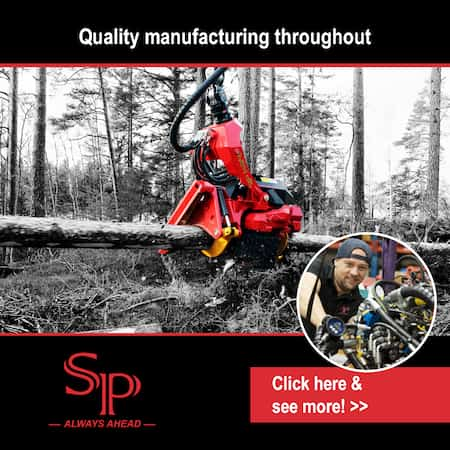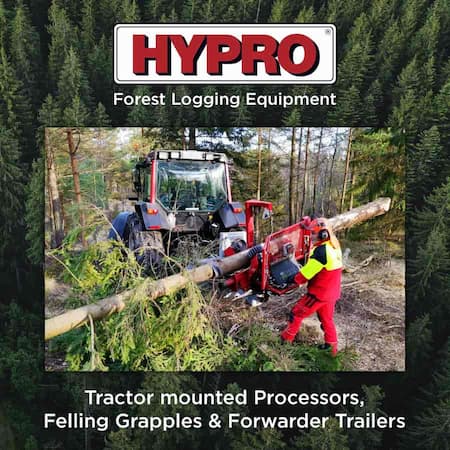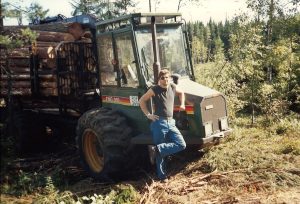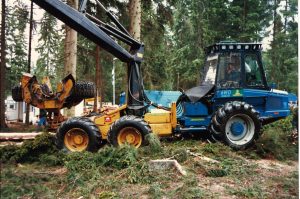In August I wrote about the first machine I operated, a Rottne two-grip processor – Rottne Blondin Snoken 810 FD. After that, I switched employers and came to a contractor who had several machines of different brands. It was a good start to my career to get the opportunity to try different machines.
Forest machine biography
The sad thing is that I, who always had the camera within reach, rarely have taken photos of the machines I operated. It was everyday life and nothing special, nothing worth photographing I thought. In retrospect, everyday life is one of the most interesting things to document. Most pictures I have of “my” machines are taken in Germany when I was living and working there.
In this article, I try to compensate for the lack of photos with links to descriptions of the machines I operated. Some are in English, but most of what I found is in Swedish and German. But I hope the technical descriptions are understandable for most readers with machine experience.
Four years backward
Machine no 1, the Rottne Snoken mentioned above, was brand new when I started operating it. No 2 was almost the same model but four years older. The difference was that no 2 had six-lever crane controls and roller-drive of the bogies. Otherwise, the machines were quite similar.
As mentioned above, this employer had several machines, so I got to try some. However, as I once started with Rottne machines I mainly operated those. The company had e.g., one Rottne Blondin with a Bruks chipper and another with a Wadell scarifyer. I operated both, but I must say that the Blondin was unsuitable for that application. It was simply too weak. But as a processor and forwarder, the Blondin was excellent.
Other brands in the company
Until the second half of the 80s, this company had had only Rottne machines. Just before I joined them, they started to buy other brands. One of the first was a Kockum 850 with a Bruks chipper. The next one was an ÖSA 260 harvester, a two-grip harvester – a real harvester (according to some of us oldies).
After a few years, when the ÖSA 260 was getting old, I got to operate it for a while. It was indeed an impressive machine. But for me, being used to the simple Rottne Blondins, it was complicated. It was a jungle of buttons, relays, and cables that were difficult to handle when something broke down (which old machines do). But when it was running, it was like being in heaven.
They also had an ÖSA/FMG 250 forwarder that I operated for a short while. This machine was newer than the 260 but it was hard to believe that it was the same brand. If you ask me the 250 was a joke with its low front and stiff steering (it was an 8-wheeler). It was also unstable in the rear. I think I was the only one who never managed to roll over with it, just luck of course. It’s an enigma to me how the 250 became so popular, but it certainly did.
There was an old Kockum 84-31 forwarder in the company as well. Something like a spare machine. I was supposed to operate that one but underway to the first site it caught fire in the middle of a small forest road and “disappeared”. I never even got to try the crane.
The good thing about that was that it was well-insured. I got a new Lokomo/FMG 910 as replacement after using (and almost burning) a Mini Bruunett for a short while waiting for the Lokomo. I can’t say I liked the Mini Bruunett even though it was better than the ÖSA 250. As I hinted within brackets; I almost burned that one too the same week I burned the Kockum. That would have been something for my CV. I forgot to loosen the brakes when moving the machine. The smoke that came out of the waist of the machine was much too familiar … but I managed to stop it this time and there was no damage to the machine.
The arrival of the Lokomo 910 was a relief. A wonderful machine that I loved from day one. Quite like a Rottne Blondin. Simple, reliable, and easy to operate. Still my favorite forwarder to this day.
Photo: KAJ
Apart from those machines, there was a Volvo 969 that had replaced a Blondin to pull the scarifyer. We didn’t do much scarifying, eventually, that machine was used mainly as a towing machine to rescue other machines from the mud. I operated it for some days and my impression was that it was big and clumsy, and unmodern, which it was.
Moving on
It was time to move on again. A new machine, a new employer, and a new location. I moved some 80 kilometers to work for a one-machine contractor. The machine was a Rottne Rapid two-grip harvester that we worked shifts on, me and the owner. It was my first experience with computer-supported bucking – automatic bucking. It took a while to get used to the machine making its own decisions. But I had no choice, that was the future.
Photo: Per Jonsson
I operated that machine for 15 months until the forest jobs in Sweden started to disappear. Like many others, I then went to Germany to work. But not for a Swedish company which most operators did. I worked for a German contractor.
More on that in #3.
Stay tuned!















